
Professor Gérard Mourou, winner of the 2018 Nobel Prize in Physics, visited Peking University and ma
source:Laserfair
release:Nick
keywords: laser technology; Nobel Prize
Time:2018-11-23
"The 21st lecture of Peking University's 100-year Physics Forum" and "Peking University Nobel Prize Winners Campus Activities" was held on October 12, 2018 at Peking University. This year's forum invited Professor Gérard Mourou, winner of the 2018 Nobel Prize in Physics, to visit Peking University and present a public lecture entitled "ELI Extreme Optics Research and Future Development: High Energy Single-Cycle Laser Science". The event was hosted by Peking University and hosted by Peking University School of Physics and International Cooperation Department.
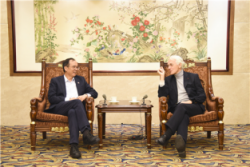
Lin Jianhua and Gérard Mourou
Professor Lin Jianhua, President of Beijing University, met with Gérard Mourou at the Yingjie Exchange Center.
On behalf of Peking University, Lin Jianhua first expressed his congratulations on Gérard Mourou's 2018 Nobel Prize in Physics and welcomed Mourou's visit to Peking University and academic exchanges. He then discussed with Mourou his important work in the field of super-strong lasers and its wide-ranging impact. Lin Jianhua said that Mourou's awards have a great incentive for young students, and believe that the close communication between Mourou and the North University will have a profound impact on them. Finally, on behalf of Peking University, Lin Jianhua presented Mourou with the 120th anniversary of the establishment of Peking University.
Gérard Mourou gave an academic speech at the Siyuan Multi-function Hall, West Building, School of Physics, Peking University. More than 600 teachers and students from Peking University and sister universities listened to the wonderful speeches of the masters. The speech was hosted by Li Wei.
Before the official start of the speech, Vice President Gong Qihuang presented Gérard Mourou with the “Peking University Centennial Physics Forum Commemorative Card”.
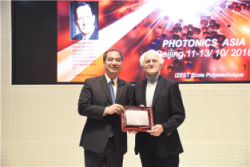
Gong Qihuang presented Gérard Mourou with "The Peking University Centennial Physics Forum Commemorative Card"
In the speech, Gérard Mourou first introduced what is the Pulse Amplification Technology (CPA). The invention of this technology greatly increases the power of the laser, for example up to 10PW (1PW = 10^15W). At the same time, he also introduced some scientific applications of chirped pulse amplification technology, such as laser proton accelerator and tail field electron accelerator. It is worth mentioning that it was because of the invention of this technology that Mourou and his student Donna Strickland won the Nobel Prize in Physics this year. Mourou mentioned that by working with the Peking University Laser Acceleration Laboratory, they have discovered a new proton acceleration method, single-cycle laser acceleration, which can increase the proton acceleration efficiency by 3-4 times compared to the existing optical pressure acceleration, and it is expected to accelerate protons to several GeVs. Scientists have planned to compress a single-cycle laser pulse into a single-cycle x-ray laser through relativity. Mourou believes that through this research, science and technology will soon enter the era of Exa (10^18W) and leap seconds (10^-21s). He then introduced the application of x-ray laser pulses, such as the x-ray crystal accelerator to further increase the acceleration gradient of the laser. Finally, Mourou looks forward to the future of super-strong laser physics, pointing out that super-strong laser still has a lot of room for development. “The best is yet to come”
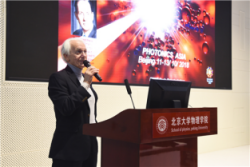
Gérard Mourou speaks
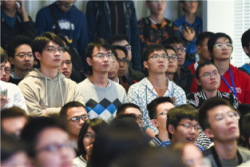
After the speech, the teachers and students on the scene had a close communication and interaction with Gérard Mourou on some interesting issues.
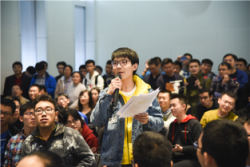
On-site student question
Profile:
Gérard Mourou, French scientist, professor. One of the pioneers in the field of electrical engineering and high-energy lasers, won the 2018 Nobel Prize in Physics for inventing chirped pulse amplification (CPA) with Canadian scientist Donna Strickland. During his more than 50 years of research, Mourou has made many pioneering contributions in the field of laser technology. With the efforts of Mourou and other scientists, Europe launched the Extreme Light Infrastructure in 2012. The three laboratories of the facility are located in the Czech Republic, Hungary and Romania, and it is planned to build a super-high laser of 10 Patawa. Such lasers can be used not only for high-energy particle acceleration, extreme high-brightness X and gamma light sources, photonuclear physics, but also for nonlinear vacuum physics to test the basic laws of quantum electrodynamics.
Gérard Mourou and Donna Strickland invented CPA technology in the late 1980s. This technology utilizes the characteristics of a short pulse laser with a wide spectrum: First, a pair of gratings are used to stretch the tens of thousands of times of the short-pulse laser in time, and then the energy is amplified by a medium such as a crystal to the limit of the crystal destruction threshold, and then the amplified laser pulse is compressed by another pair of gratings in a vacuum to its original pulse width. Since the invention, the technology has increased the intensity and power of laser pulses by 7 to 8 orders of magnitude, thereby propelling laser-substance interaction research into new areas that were previously unimaginable. At present, lasers using CPA amplification technology can generate laser pulses with pulse widths of several tens of femtoseconds (10-15 seconds) and peak powers of up to 10 watts (10^15 watts). There are dozens of laboratories around the world that conduct basic science and applied research based on this ultra-short and ultra-strong laser pulse.
CPA technology has opened up a whole new field for basic science and applied scientific research. It enables lasers to cut and drill holes on various materials with extremely high precision, and thus has a wide range of applications in industry and medical fields. In the field of basic science, the application of CPA technology is more extensive and deep, from ultrafast nonlinear spectroscopy, attosecond science, new high-energy particle accelerators, to high-energy density science, and even laser fusion research. In 2010, Nature predicted six laser-related scientific breakthroughs in the next decade, four of which are closely related to ultra-short and ultra-strong lasers, including mesa electronics and proton accelerators, laser fusion, all-optical clocks and attosecond science.
- RoboSense is to Produce the First Chinese Multi-beam LiDAR
- China is to Accelerate the Development of Laser Hardening Application
- Han’s Laser Buys Canadian Fiber Specialist CorActive
- SPI Lasers continues it expansion in China, appointing a dedicated Sales Director
- Laser Coating Removal Robot for Aircraft
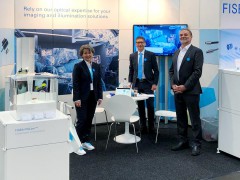 FISBA exhibits Customized Solutions for Minimally Invasive Medical Endoscopic Devices at COMPAMED in
FISBA exhibits Customized Solutions for Minimally Invasive Medical Endoscopic Devices at COMPAMED in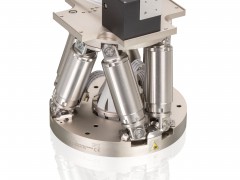 New Active Alignment System for the Coupling of Photonic Structures to Fiber Arrays
New Active Alignment System for the Coupling of Photonic Structures to Fiber Arrays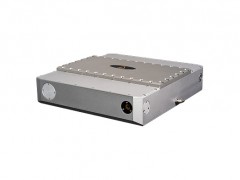 A new industrial compression module by Amplitude
A new industrial compression module by Amplitude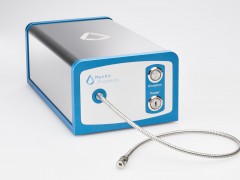 Menhir Photonics Introduces the MENHIR-1550 The Industry's First Turnkey Femtosecond Laser of
Menhir Photonics Introduces the MENHIR-1550 The Industry's First Turnkey Femtosecond Laser of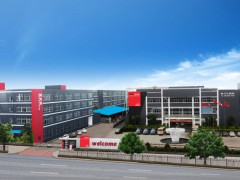 Shenzhen DNE Laser introduced new generation D-FAST cutting machine (12000 W)
more>>
Shenzhen DNE Laser introduced new generation D-FAST cutting machine (12000 W)
more>>
